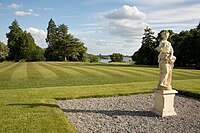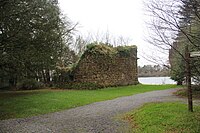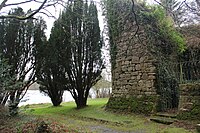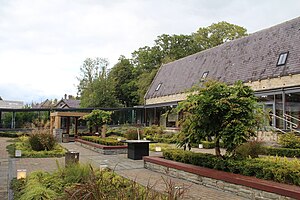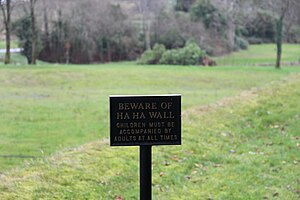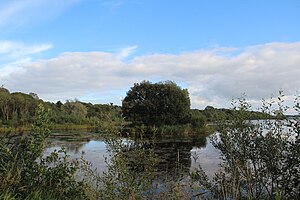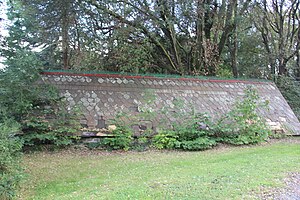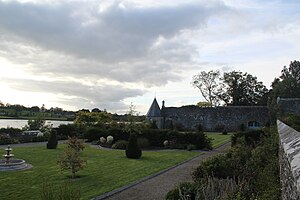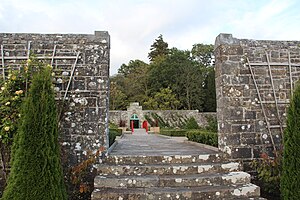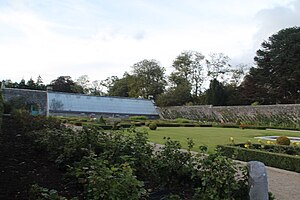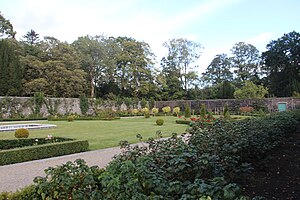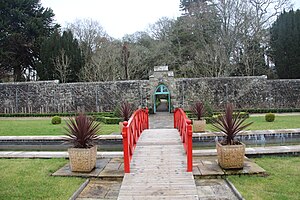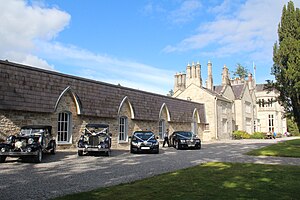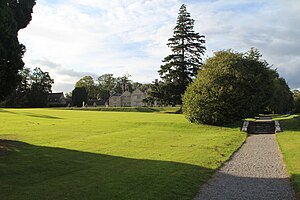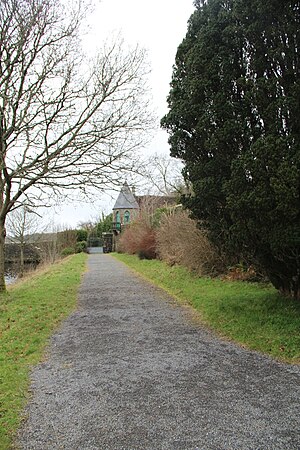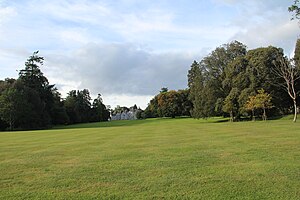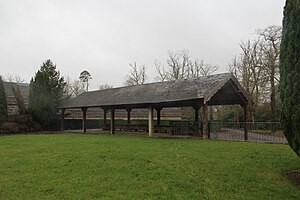Difference between revisions of "Lough Rynn Castle"
| Line 16: | Line 16: | ||
'''Lough Rynn Castle''' is a luxury castle hotel on the shores of [[Rinn Lough|Lough Rynn]] (or 'Rinn Lough') in [[County Leitrim]], standing on the historic grounds of the mediæval castle and estate of the Mac Raghnaill family of Muintir Eolais. | '''Lough Rynn Castle''' is a luxury castle hotel on the shores of [[Rinn Lough|Lough Rynn]] (or 'Rinn Lough') in [[County Leitrim]], standing on the historic grounds of the mediæval castle and estate of the Mac Raghnaill family of Muintir Eolais. | ||
| − | The estate is laid out on an isthmus between the lakes of Lough Rynn and | + | The estate is laid out on an isthmus between the lakes of Lough Rynn and Errew Lake.<ref name="loughRynn12001621">{{cite web | url=http://www.loughrynn.net/id17.htm | title=Lough Rynn - 1200–1621 AD | accessdate=18 March 2012}}</ref> It is some two and a half miles from [[Mohill]]. |
[[File:Lough Rynn statue.jpg|right|thumb|200px|View towards Lough Rynn]] | [[File:Lough Rynn statue.jpg|right|thumb|200px|View towards Lough Rynn]] | ||
| Line 61: | Line 61: | ||
===Gardens=== | ===Gardens=== | ||
| − | A four-hundred-year-old oak tree still exists on the grounds of the estate, as does a Bronze Age tomb named ''Cloch an Draoi'' ('Druid's Altar') on The Druid's Hill between | + | A four-hundred-year-old oak tree still exists on the grounds of the estate, as does a Bronze Age tomb named ''Cloch an Draoi'' ('Druid's Altar') on The Druid's Hill between Errew Lake and Lough Rynn, which can be dated between 1900BC and 300BC.<ref>{{cite web | url=http://www.clooncahirlodge.com/History_of_Lough_Rynn.html | title=Druid's Altar Portal Tomb | accessdate=18 March 2012}}</ref> |
{| | {| | ||
|[[File:Cloch an Draoi (Druid's Altar).jpg|thumb|''Cloch an Draoi'' (Druid's Altar)]] | |[[File:Cloch an Draoi (Druid's Altar).jpg|thumb|''Cloch an Draoi'' (Druid's Altar)]] | ||
|[[File:Ha Ha Wall sign.JPG|thumb|Ha-ha sign]] | |[[File:Ha Ha Wall sign.JPG|thumb|Ha-ha sign]] | ||
|} | |} | ||
| − | There are also sawmills, a farmyard, arboretum, green house, French stable yards, nature trails, and terraced gardens. There are two bridges across the Rynn river which connects | + | There are also sawmills, a farmyard, arboretum, green house, French stable yards, nature trails, and terraced gardens. There are two bridges across the Rynn river which connects Errew Lake and Lough Rynn, the Red Bridge and the Blue Bridge. The principal walkway across the estate starts at the Castle, veers left by the 'Ha-ha wall and Blue Bridge on your left-hand side. |
Turn right with the path and you pass the crannóg in Lough Rynn as you walk towards the Boathouse. | Turn right with the path and you pass the crannóg in Lough Rynn as you walk towards the Boathouse. | ||
| Line 91: | Line 91: | ||
|[[File:Lough Rynn Walled Garden1.JPG|thumb|Upper walled garden]] | |[[File:Lough Rynn Walled Garden1.JPG|thumb|Upper walled garden]] | ||
|[[File:Lough Rynn Walled Garden8.JPG|thumb|Upper walled garden]] | |[[File:Lough Rynn Walled Garden8.JPG|thumb|Upper walled garden]] | ||
| − | |[[File:Lough Rynn River joining Rynn and Errew lakes.JPG|thumb|Lough Rinn/Rynn river joining Rynn and | + | |[[File:Lough Rynn River joining Rynn and Errew lakes.JPG|thumb|Lough Rinn/Rynn river joining Rynn and Errew Lakes]] |
|} | |} | ||
{| | {| | ||
Latest revision as of 12:34, 19 June 2019
| Lough Rynn Castle Irish: Caisleán Loch na Reanna | |
|
County Leitrim | |
|---|---|
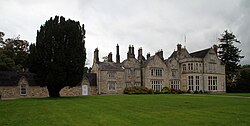 Lough Rynn Castle | |
| Location | |
| Grid reference: | N10109381 |
| Location: | 53°53’38"N, 7°50’50"W |
| History | |
| Information | |
| Condition: | Convrted to hotel |
| Website: | https://www.loughrynn.ie/ |
Lough Rynn Castle is a luxury castle hotel on the shores of Lough Rynn (or 'Rinn Lough') in County Leitrim, standing on the historic grounds of the mediæval castle and estate of the Mac Raghnaill family of Muintir Eolais.
The estate is laid out on an isthmus between the lakes of Lough Rynn and Errew Lake.[1] It is some two and a half miles from Mohill.
Contents
History
Mac Raghnaill family ( –1621)
The current Lough Rynn estate is built on the ancestral lands of Clan Maelsechlainn-Oge Mac Raghnaill, the rulers of Muintir Eolais as this part of County Leitrim was known, before the Tudor reconquest of Ireland. The Annals of Loch Cé and Annals of Connaught refer to "the crannóg of Claenloch" (Lough Rynn) in the High Middle Ages, 1247AD,[2][3] with the structure marked on some maps as "Crannoge" [4] or "Crane Island",[5] while the mediæval Mac Raghnaill's Castle is mentioned in 1474AD.[6]
The ruins of the Mac Raghnaill's Castle are located close to the lake and some 500 yards from the existing Lough Rynn Castle. The historian, Fiona Slevin, describes the structure of the Mac Raghnaill castle as "fairly standard for the time, but it did have a few unusual - and clever - features. Although a square shape, the castle had rounded corners that made it more impervious to artillery attacks and it had a straight stairway carved into the hollow of a wall, rather than the more usual spiral stair in one corner."[7]
In the Nine Years' War through which the Tudor reconquest of the land was achieved, the Mac Raghnaill family opposed the English and allied themselves with Aodh Mór Ó Néill.
Crofton family (1621–1750)
In the English Plantation of 1621, the Mac Raghnaill lands in Lough Rynn were confiscated and granted to an English family named Crofton. The Croftons brought Protestant settlers with them from Great Britain and in the 1620s and 1630s the native Irish were gradually removed from the land.
Clements family (1750–1970s)
In 1750, the Croftons were replaced by another English family named the Clements. Daniel Clements, an officer in Oliver Cromwell's army, had been granted land in County Cavan which had been confiscated from the Irish following the Cromwellian conquest of Ireland.[8] In 1750 Nathaniel Clements acquired the Lough Rynn estate, while remaining on his lands in Cavan.
In 1795 Robert Clements became the first Earl of Leitrim.[9]
In 1833, Robert Bermingham, Viscount Clements, built a mock Tudor revival house overlooking Lough Rynn.[10] It is this property which is the basis for the current Lough Rynn Castle.
William Sydney Clements, 3rd Earl of Leitrim
When William Sydney Clements became the 3rd Earl of Leitrim in 1854, he inherited an estate of a massive 90,000 acres which stretched across four counties. He had a very different approach form that of his father and his authoritarian manner won him many opponents among the tenantry. The inability of tenants to pay rent during and after the Great Famine provided him with an opportunity to clear his estate and introduce more productive farming practices.
In 1858, in a nationally reported event, Clements assembled one thousand armed military and police to repossess the local Gortletteragh Church for non-payment of rent, rent which his liberally-minded father had refused to take. However, some six thousand men turned up from Longford, Westmeath, Roscommon and across Leitrim on the day to defend the church, forcing Clements to back down.[11] The Nation (a nationalist newpaper) noted at this time that Lord Leitrim was `already famous for such proceedings towards his tenantry as not many even of his own order dare imitate'.[11]
During the 1860s hatred towards the Earl grew in the surrounding area and stories began to be told of his mistreatment of the wives and daughters of local men. In September 1860 James Murphy from Mohill fired a loaded pistol at him, two days after sending him a note challenging him to a duel to 'take satisfaction for your ruffianly conduct towards my wife'.[11] An additional attempt to shoot him followed in the 1860s. By the 1870s Lord Leitrim was arguably the most infamous landlord in Ireland, symbolising 'evil at its worst'.[12] In Donegal in particular Clements was the object of deep resentment and had to travel under armed military escort. In 1878 Clements engaged in a wholesale eviction of his tenants there, many of whom were starving as a result of the famine which hit north-western Ireland in 1878/79. On 2 April 1878 three men, Michael Heraghty, Michael McElwee and Neil Sheils, ambushed and killed William Sydney Clements, 3rd Lord Leitrim, at Cratlagh Wood near Milford, County Donegal.[12]
Leitrim's assassination received widespread publicity in Ireland and abroad, with proponents of land reform using it as evidence of the need to protect tenants from the abuses of tyrannical landlords. His funeral in Dublin was marked by further riots, while none of the three assassins were convicted of his death.[12]
Extension and refurbishment of the castle (1889)
The inheritor of the Lough Rynn estate was Sydney Clements' English-educated cousin who lived in Cavan, Colonel Henry Theophilus Clements, rather than the heir presumptive to the title who lived in England. This Colonel Clements embarked on an extensive expansion and refurbishment of the castle. He added a new wing, built a Baronial Hall designed by Thomas Drew with heavy plaster cornices, a large ornate Inglenook fireplace, and a fretted ceiling and walls wainscoted in solid English oak.[13] Upon its completion in 1889, the principal floor of the house contained a main hall, Baronial Hall, chapel, reception room, living room and dining room. Two pantries, a kitchen, study, smokehouse and store were accessed by a separate entrance. In the basement there were stores and a wine cellar. There were fourteen bedrooms and four bathrooms upstairs.[13]
By 1952, when Marcus Clements took over the Lough Rynn estate, most of it had been sold off to former tenants under the land acts of the late nineteenth and early twentieth centuries. Clements lived there until the 1970s. The estate remained largely empty until 1990 when it was purchased by an Irish-American investor, Michael Flaherty.[13] In the early twenty-first century Lough Rynn estate was purchased by the current owners, the Hanly family. They invested substantially in overhauling and modernising the house and estates. In September 2006 when Lough Rynn Castle finally opened as a hotel, the estate extended to three hundred acres.
Hotel
Castle
Lough Rynn Castle Hotel now has forty-two bedrooms, a baronial hall, a library named after John McGahern, drawing room, piano room, bar, the award-winning Sandstone restaurant, as well as conference, bar and wedding facilities for up to three hundred guests in an adjoining function room.
Gardens
A four-hundred-year-old oak tree still exists on the grounds of the estate, as does a Bronze Age tomb named Cloch an Draoi ('Druid's Altar') on The Druid's Hill between Errew Lake and Lough Rynn, which can be dated between 1900BC and 300BC.[14]
There are also sawmills, a farmyard, arboretum, green house, French stable yards, nature trails, and terraced gardens. There are two bridges across the Rynn river which connects Errew Lake and Lough Rynn, the Red Bridge and the Blue Bridge. The principal walkway across the estate starts at the Castle, veers left by the 'Ha-ha wall and Blue Bridge on your left-hand side.
Turn right with the path and you pass the crannóg in Lough Rynn as you walk towards the Boathouse.
Beyond the Boathouse is the remains of the Mac Raghnaill mediæval castle at another shore of Lough Rynn. A left after the castle will bring you to the Rockery and Wishing Chair next to the lake. A right along the shore at this point will lead to the back entrance of the estate's centerpiece, the enormous three-tiered walled gardens which overlook the lake.
Originally constructed between 1855 and 1860,[15] upon their reopening on 5 August 2008 Lough Rynn Castle's walled gardens were the largest privately owned walled gardens in Ireland.
Pictures
References
- ↑ "Lough Rynn - 1200–1621 AD". http://www.loughrynn.net/id17.htm. Retrieved 18 March 2012.
- ↑ "Annals of Connaught, 1247.5". http://www.ucc.ie/celt/published/T100011/text024.html.
- ↑ "Annals of Loch Cé, LC1247.4". http://www.ucc.ie/celt/published/T100010A/text011.html.
- ↑ "Map identifying "crannóg of Claenloch (Lough Rynn)" as 'Crannoge'". http://maps.osi.ie/publicviewer/#V2,610027,793542,11,9.
- ↑ "Map identifying "crannóg of Claenloch (Lough Rynn)" as 'Crane Island'". http://maps.osi.ie/publicviewer/#V2,610027,793542,11,7.
- ↑ "Annals of Connaught, 1474.16, 'Rinn Castle' or 'Caslen in Renna'". http://www.ucc.ie/celt/published/T100011/text237.html.
- ↑ By Hereditary Virtues: a History of Lough Rynn. ISBN 0-9553883-0-9
- ↑ "Lough Rynn - The arrival of the Clements family". http://www.loughrynn.net/id18.htm. Retrieved 18 March 2012.
- ↑ "Lough Rynn - Robert Clements, 1st Earl of Leitrim 1732–1804". http://www.loughrynn.net/id61.htm. Retrieved 18 March 2012.
- ↑ "Lough Rynn - Robert Bermingham, Viscount Clements 1805–1839". http://www.loughrynn.net/id30.htm. Retrieved 18 March 2012.
- ↑ 11.0 11.1 11.2 "Lough Rynn - After the famine". http://www.loughrynn.net/id35_tenant_relations.htm. Retrieved 18 March 2012.
- ↑ 12.0 12.1 12.2 "Lough Rynn - Assassination". http://www.loughrynn.net/id41.htm. Retrieved 18 March 2012.
- ↑ 13.0 13.1 13.2 "Lough Rynn - After Lord Leitrim". http://www.loughrynn.net/id42.htm. Retrieved 18 March 2012.
- ↑ "Druid's Altar Portal Tomb". http://www.clooncahirlodge.com/History_of_Lough_Rynn.html. Retrieved 18 March 2012.
- ↑ "Lough Rynn Walled Gardens, County Leitrim". http://www.buildingsofireland.ie/niah/search.jsp?type=record&county=LE®no=30935006. Retrieved 18 March 2012.
| ("Wikimedia Commons" has material about Lough Rynn) |
